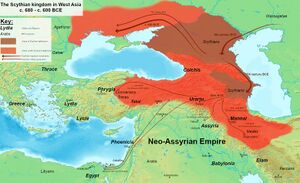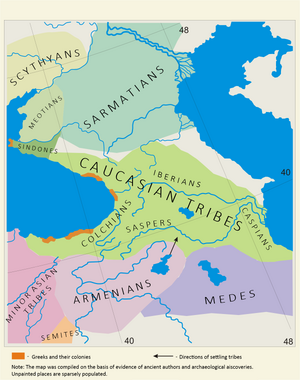Colchis
| Author:Laxman Burdak, IFS (Retd.) |


Colchis was an exonym for the Georgian polity of Egrisi (Also known as Egri, Egr, Eguri and Egros in The Georgian Chronicles and Conversion of Kartli chronicles. Old Armenian chronicles referred to it as Yeger.) [1][2] (Georgian: ეგრისი) located on the coast of the Black Sea, centered in present-day western Georgia.
Variants
- Colchians (Anabasis by Arrian, p. 234, 394.)
- Colchians
- Kolchis; /ˈkɒlkɪs/; Greek: Κολχίς, Kolkhís, Ancient Greek pronunciation: [kolkʰís]
- /ˈkɒlkɪs/;
- Ancient Greek: Κολχίς
- Colica[3]
- Colchi
- Colchians (Natural History by Pliny Book VI/Chapter 7)
Jat Gotras Namesake
- Coli[4] = Colchians (Natural History by Pliny Book VI/Chapter 7)
- Kori[5] = Colchians (Natural History by Pliny Book VI/Chapter 7)
Jat Gotras Namesake
- Coli[6] = Colchians (Anabasis by Arrian, p. 234, 394.)
- Kori[7] = Colchians (Anabasis by Arrian, p. 234, 394.)
Migrations from Indian to north western countries
Hukum Singh Panwar (Pauria)[8] writes that We may now cite at some length from Pococke[9] who has traced Indian migrations to all corners of the world solely through linguistic similarities. This extreme reliance on phonetic similarities seems to weaken his argument, but there is ample support, from other disciplines, techniques and lines of investigation, for his claims. Further, the large body of data, he has massed together cannot be brushed away lightly. When supported by other evidence, his thesis becomes incontrovertible. According to Pococke a great number of adventurous preux chevalier tribes from India migrated to Spain, Italy, Greece, Asia Minor,Persia, Colchis, Armenia and the Caucasus region, all of which provide distinct and startling evidence of Indian colonization in great profusio. We have tried (Appendix No.6) to pinpoint the Indian names and places of the origin of the migrated tribes as well as the altered forms of their names in their new settlements in other countries. The appendix indicating all this, is by no means, exhaustive. It may not be unnecessary here to point out that in some countries the presence of Indian tribes can be construed by their names, though distorted, while, in others their identity can be traced by place names in these transformed phonemic nomenclatures. All the more significant is the fact that almost all the tribes are considered Saca-Getae (Jats) or Scythians by the learned scholar[10].(cf. Appendix No.6).
Pococke[11] believes that the major migrations took place from India as a result of internecine wars and religious persecutions in which the Buddhists had been the main victims.
To these may be added the Parasurama-Haihayas (Scythians) wars, Sagar's war against Haihayas and their allies (Sakas, Parthas,Pahlavas etc) the Dasarajna Wars, the Rama-Ravana Yudha, the Mahabharata war. Pococke lays special stress on the virulent religious strife for a long time between the Brahmins and the Buddhists for supremacy, leading to Brahmanic victory and the gigantic expulsion of the Buddhists. Pococke claims[12] that this was the most crucial event which compelled migrations and
The Jats:Their Origin, Antiquity and Migrations:End of page 307
banishment of the vanquished to the north-western countries. The Saga of the Kurus and Pandus, though ostensibly political was in reality, as Pococke[13] contends, a struggle between the Brahminical and the Buddhistic parties. Profound night clouds this portion on Indian history. What Pococke regards as clear is that the emigrants coasted along the shores of Mekran, traversed the mouth of Persian Gulf. Adhering to the sea-board of Oman, Hadramant and Yemen (the Eastern Arabia), they sailed up the Red Sea, and ascending the mighty stream - the Nile - that fertilizes a land of wonders, founded the kingdoms of Egypt, Nubia, Abyssinia[14] and Ethiopia. Fhilostratus, Julius Africanus, Eusebius and Syncellus, the Greek writers[15] assert that the Ethiopians were originally an Indian race, emigrated from the river Indus and settled in the vicinity of Egypt. This assertion cannot be dismissed lightly.
History
The Colchians are generally thought to have been an early Kartvelian-speaking tribe ancestral to the contemporary western Georgians, namely Svans and Zans.[16]
According to David Marshall Lang: "one of the most important elements in the modern Georgian nation, the Colchians were probably established in the Caucasus by the Middle Bronze Age."[17]
It has been described in modern scholarship as "the earliest Georgian formation", which, along with the Kingdom of Iberia, would later contribute significantly to the development of the Kingdom of Georgia and the Georgian nation.[18]
Colchis is known in Greek mythology as the destination of the Argonauts, as well as the home to Medea and the Golden Fleece.[19] It was also described as a land rich with gold, iron, timber and honey that would export its resources mostly to ancient Hellenic city-states.[20]
Colchis likely had a diverse population. According to Greek and Roman sources, between 70 and 300 languages were spoken in Dioscourias (modern Sukhumi) alone.[21]
According to Rayfield, the first mention of Colchis is during the reign of the Assyrian king Tukulti-Ninurta I (1245–1209 BC) when he mentions "40 kings by the Upper[Black] Sea".[22]
Abkhaz, Scythian, Anatolian, and Greek names have all been identified in Colchis. Any of these groups could have constituted the ruling class.[23]
Geography
Its geography is mostly assigned to what is now the western part of Georgia and encompasses the present-day Georgian provinces of Samegrelo, Imereti, Guria, Adjara, Abkhazia, Svaneti, Racha; modern Russia's Sochi and Tuapse districts; and present-day Turkey’s Artvin, Rize, and Trabzon provinces.[24]
Mention by Strabo
Strabo wrote:
- And on the sea lies the Asiatic side of the Bosporus, or the Syndic territory. After this latter, one comes to the Achaei and the Zygii and the Heniochi, and also the Cercetae and the Macropogones. And above these are situated the narrow passes of the Phtheirophagi (Phthirophagi); and after the Heniochi the Colchian country, which lies at the foot of the Caucasian, or Moschian, Mountains. (Strabo, Geographica 11.2)
Mention by Pliny
Pliny[25] mentions...At the back of the mountains of this district is Iberia, while on the coast are the Heniochi, the Ampreutæ25, the Lazi, the rivers Acampsis,26 Isis,27 Mogrus, and Bathys,28 the nations of the Colchi, the town of Matium,29 the river Heracleum and the promontory of the same name,30 and the Phasis,31 the most celebrated river of Pontus.
25 It is suggested by Hardouin that these are the same as the Zydretæ mentioned in the Periplus of Arrian, and by him placed between the Heniochi and the Lazi.
26 See note 91.
27 Supposed to be the same as the modem Tshorok.
28 Or "Deep" River. This stream may possibly be identified by observing that Pliny places only one river between it and the Phasis.
29 Probably the Madia of Ptolemy, who places it in the interior.
30 At the present day called Eraklia, according to Parisot.
31 Now called the Faz or Poti'.
Mention by Pliny
Pliny[26] mentions ....Below this lies the region of Pontus known as Colica1, in which the mountain chain of Caucasus bends away towards the Riphæan mountains, as we have previously2 mentioned; one side running down towards the Euxine and the Lake Mæotis, the other towards the Caspian and the Hyrcanian Sea. The remaining portion of these shores is peopled by savage nations, the Melanchlæni3, and the Coraxi, who formerly dwelt in Dioscurias4, near the river Anthemus, now deserted, but once a famous city. 1. 16 Inhabited anciently by the Coli, and constituting the northern portion of ancient Colchis.
2. In B. v. c. 27.
3. Or nation "with the black cloaks," from some peculiarity in their dress.
4. This was the great trading-place of the wild tribes in the interior; and so numerous were they, that the Greeks asserted that there were seventy different languages spoken in the market of Dioscurias (modern Sukhumi) .
Mention by Pliny
Pliny[27] mentions Lake Mieotis and the adjoining nations.... There are some writers who state that there are the following nations dwelling around the Mæotis, as far as the Ceraunian mountains;13 at a short distance from the shore, the Napitæ, and beyond them, the Essedones, who join up to the Colchians, and dwell upon the summits of the mountains:
13 The Ceraunian mountains were a range belonging to the Caucasian chain, and situate at its eastern extremity; the relation of this range to the chain has been variously stated by the different writers.
List of ancient Colchian tribes
This is a list of the ancient Colchian tribes.[28][29]
External links
References
- ↑ Casiday, A. (2012). The Orthodox Christian World: Routledge Worlds. Taylor & Francis. p. 59. ISBN 9781136314841.
- ↑ Rapp, S.H. (2003). Studies in Medieval Georgian Historiography: Early Texts and Eurasian Contexts. Corpus scriptorum Christianorum Orientalium: Subsidia. Peeters. p. 10. ISBN 9789042913189. "Known in Old Georgian as Egrisi, this realm gained legendary repute with the Greek myth of Jason and the Argonauts whose adventure brought them to “Colchis” (i.e., Egrisi) in pursuit of the Golden Fleece."
- ↑ Natural History by Pliny Book VI/Chapter 5
- ↑ The Jats:Their Origin, Antiquity and Migrations/Appendices/Appendix No.6,sn.6
- ↑ The Jats:Their Origin, Antiquity and Migrations/Appendices/Appendix No.6,sn.6
- ↑ The Jats:Their Origin, Antiquity and Migrations/Appendices/Appendix No.6,sn.6
- ↑ The Jats:Their Origin, Antiquity and Migrations/Appendices/Appendix No.6,sn.6
- ↑ The Jats:Their Origin, Antiquity and Migrations/The identification of the Jats, pp.307-308
- ↑ Pococke, E; India in Greece, Indian Reprint, 1972, p. 32, 47, 134.
- ↑ Ibid., pp.38, 51ff, 63, 70, 124, 148, 159, 178, 195, 205, 229, 242, 251, 255,300.
- ↑ For further study please cf. C. Wordsworth, D.O., 'Greece, Pictorial and Descriptive; Grote, His. of Greece; Niebuh" His. of Rome; Troyer, Ramayana; Tod, Ann; Is and Antiquities of Rajasthan; Ency. Metropolitania; Smith, Muth. Lex., vol.I Homer, Odessey, Iliad; Asiatic Researches; Mure, His. of Greek Literatura, . Vol.I; Strabo's Geographia; Wilson, skt. Les.; Kruse, Hellas; Smith, Dic. of Astiq.; Hamilton E, Ind. Gaz., Vol.I; Thoronton, Geog. of Ph.; Thirliwall, His. of Greece; Thueydide, Genesis and App. No. XX in Pococke's Ind. in Greece
- ↑ Ibid., Chs VI-XV
- ↑ Ibid., p. 300. Dr. Buddha Prakash describes the Epic war as the 'Saga of the Sakas'.
- ↑ Ibid., p.43
- ↑ Ibid., p. 205.
- ↑ Ivane Javakhishvili - A History of the Georgian Nation, Book I. pp 44-47..... "Colchis was mainly inhabited by Megrelian-Laz speaking tribes. Then Colchians conquered the land of the Svans."
- ↑ David Marshall Lang. The Georgians. p. 59. Frederick A. Praeger. New York (1966).
- ↑ Cyril Toumanoff, Studies in Christian Caucasian History, pp. 69, 84
- ↑ W. E. D. Allen, A history of the Georgian people (1932), p. 123
- ↑ Nigel Wilson, Encyclopedia of Ancient Greece, p. 149
- ↑ Rayfield, Donald (2012). Edge of Empires : A History of Georgia. Reaktion Books.p.14
- ↑ Rayfield 2012, p. 15.
- ↑ Rayfield 2012, p. 14-15.
- ↑ Ronald G. Suny - The Making of the Georgian Nation. Indiana University Press. Page 8
- ↑ Natural History by Pliny Book VI/Chapter 4
- ↑ Natural History by Pliny Book VI/Chapter 5
- ↑ Natural History by Pliny Book VI/Chapter 7
- ↑ COLCHIS, Encyclopædia Iranica
- ↑ D. M. Lang, The Georgians, London 1966. chap. 6
- ↑ Georgian Soviet encyclopedia, Vol. 2, pg. 422, Tb., 1977.
- ↑ Suny, Ronald Grigor (1994), The Making of the Georgian Nation: 2nd edition, p. 8. Indiana University Press, ISBN 0-253-20915-3
- ↑ Kavtaradze, Giorgi L. (2002), An Attempt to Interpret Some Anatolian and Caucasian Ethnonyms of the Classical Sources, pp. 63-83. Sprache und Kultur #3. Staatliche Ilia Tschawtschawadse Universität Tbilisi für Sprache und Kultur. Institut zur Erforschung des westlichen Denkens, Tbilissi.
- ↑ https://web.archive.org/web/20170101063545/http://www.masseiana.org/pliny.htm
- ↑ Edwards, Robert W. (1988), The Vale of Kola: A Final Preliminary Report on the Marchlands of Northeast Turkey, p. 129-130. Dumbarton Oaks Papers, Vol. 42.
- ↑ M. Inadze, Institute of History, Georgian Academy of Sciences, PROBLEMS OF ETHNOPOLITICAL HISTORY OF ANCIENT ABKHAZIA
- ↑ http://bse.sci-lib.com/article066618.html
- ↑ Historical Dictionary of Georgia by Alexander Mikaberidze, 2015, Rowman & Littlefield Publishers, isbn 978-1-4422-4146-6

